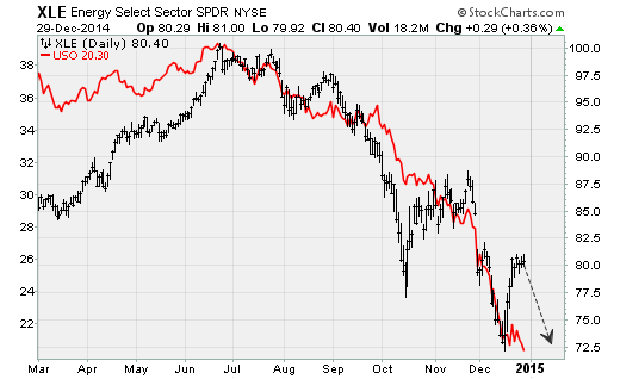Oil slide threatens "Santa Claus" rally
Between late November and mid-December, a rapid and jarring decline in oil from $77.50 a barrel down to $55 unnerved investors. Energy stocks sank. And high-yield junk bonds were abandoned on concerns that high-cost U.S. shale oil producers would see their fortunes head south along with the price of crude.
After benchmark West Texas Intermediate crude tested a low of $53.60 on December 16, the situation stabilized, allowing the major stock market averages to zoom back to new record highs in one of the most impressive short-term rebounds in market history. The Dow Jones industrial average needed just six days to gain more than 1,000 points and breach the 18,000 level for the first time ever.
But now, as Wall Street returns after the Christmas holiday, the selling has re-intensified as crude oil has fallen to fresh lows, testing below $53 a barrel, threatening to put an early end to the market's end-of-year rally.
Crude oil has formed what chartists call a classic support break -- falling out of the trading range that had held it for two weeks as prices drop back to levels not seen since the recession.
The catalyst was a drop in the count of operating U.S. oil rigs for the third week in a row to an eight-month low. We're in the midst of the fastest decline in activity since the middle of 2009. The Baker Hughes oil rig count dropped 34 last week to stand at 1,499, down from a peak of 1,609 in October.
Peter Boockvar at economic research firm the Lindsey Group notes that back in 2008, before the shale boom but during a surge in energy prices, the oil rig count topped out at 442 rigs.
While a diminishing supply of oil would be considered a bullish factor, the takeaway here is that both rig counts and energy prices have more downside before a sustainable low can be found.
Adding to the concern that the drop in energy prices, while great for consumers, is going to have an adverse effect on corporate profits and capital expenditures was highlighted by a disappointing Dallas Fed manufacturing activity report on Monday.
Although factory activity expanded, it did so at a weaker-than-expected pace and was accompanied by negative comments from survey respondents. One comment, from an executive in metal product manufacturing, said the drop in oil prices was "going to make things ugly... quickly."
Oil prices look like they have further to fall, despite some optimism that fighting near Libyan oil infrastructure could reverse the trend.
OPEC's leaders are showing no willingness to cut production to bolster prices. Global economic growth for 2015 is being marked down, with Bloomberg data showing the consensus estimate for world GDP growth down near 2.7 percent from estimates above 3.1 percent earlier this year. And currency trends remain favorable with the U.S. dollar strengthening against the Japanese yen and the euro, a dynamic that tends to push commodity prices lower since most transactions in these materials are done in dollars.
The chart above shows how energy stocks have separated from oil prices (red) during the Santa Claus rally we've seen over the last couple of weeks. If oil suffers additional weakness here, stocks will be under pressure to realign to the downside.


